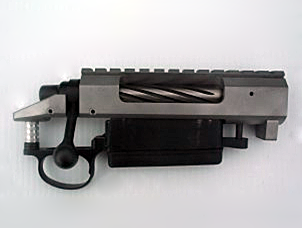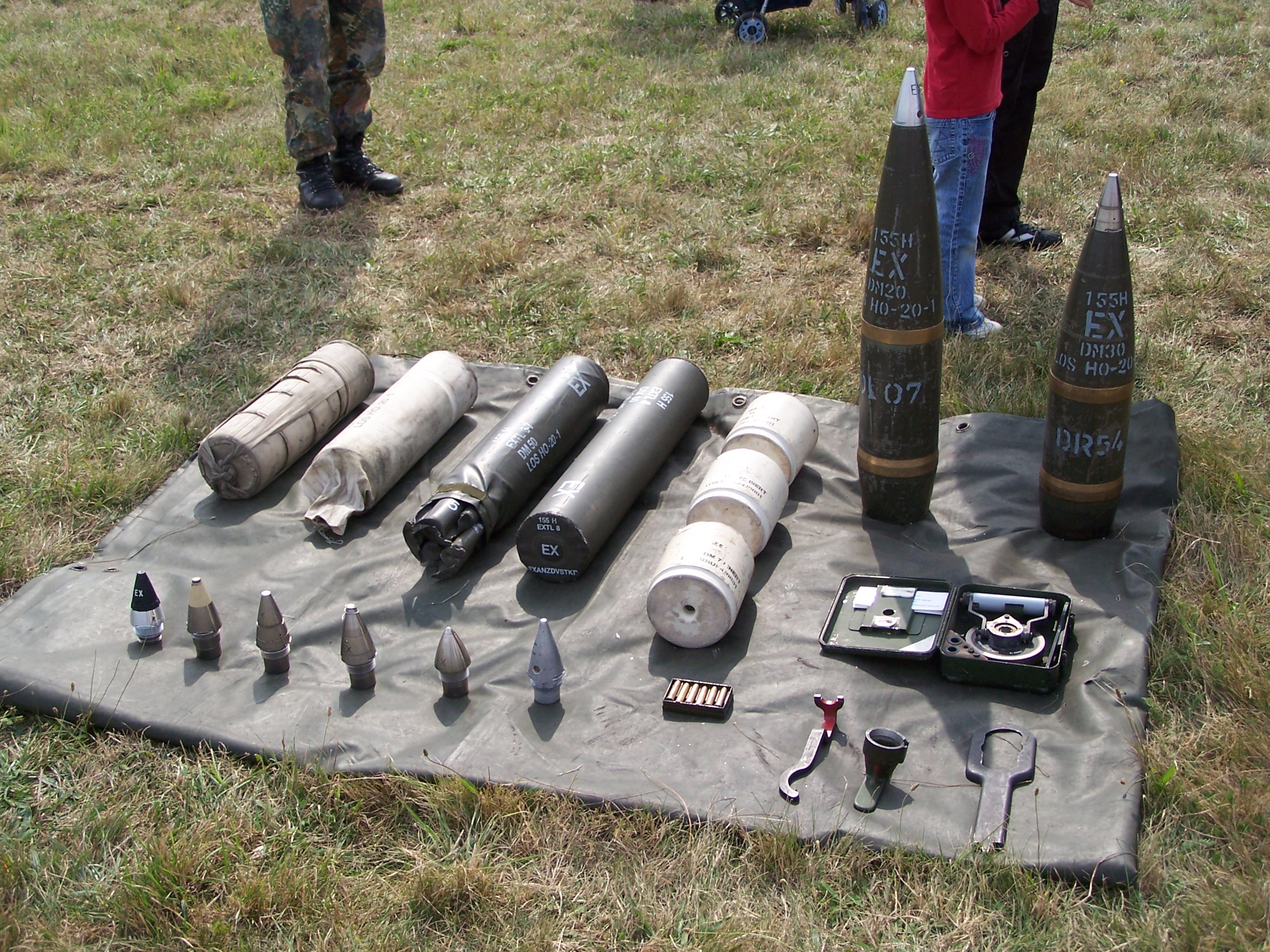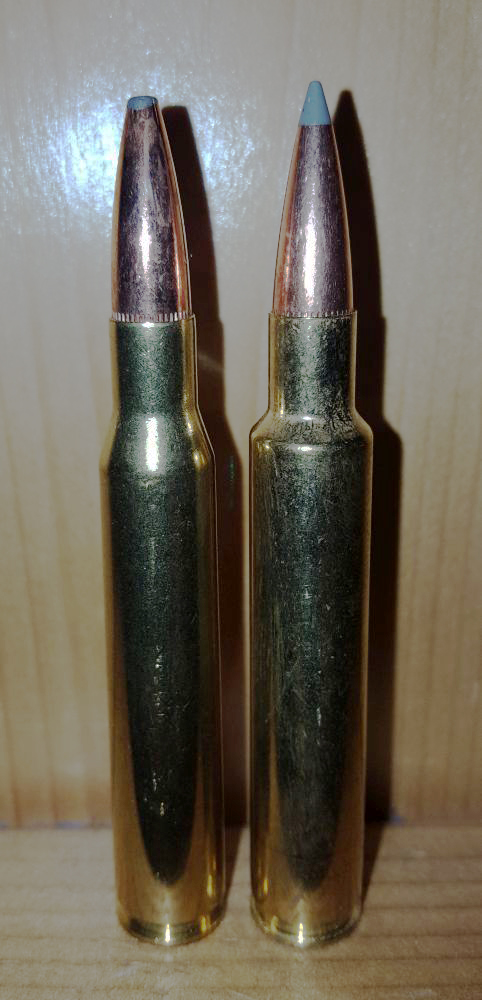|
Obturate
Obturation is the necessary barrel blockage or fit in a firearm or airgun created by a deformed soft projectile. A bullet or pellet made of soft material and often with a concave base will flare under the heat and pressure of firing, filling the bore and engaging the barrel's rifling. The mechanism by which an undersized soft-metal projectile enlarges to fill the barrel is, for hollow-base bullets, expansion from gas pressure within the base cavity and, for solid-base bullets, "upsetting"—the combined shortening and thickening that occurs when a malleable metal object is struck forcibly at one end. Obturation is achieved in shotgun shells (which have multiple pellets much smaller than the barrel bore) by placing a plastic wad or biodegradable card of the same diameter as the barrel between the propellant powder and the pellets. In a cartridge - such as a bullet or cased artillery shell - "obturation" is initiated by the action of a soft metallic cartridge case being press ... [...More Info...] [...Related Items...] OR: [Wikipedia] [Google] [Baidu] |
Glossary Of Firearms Terminology
The following are terms related to firearms and topics. A B C D E F G H I J K L M N O P R S ... [...More Info...] [...Related Items...] OR: [Wikipedia] [Google] [Baidu] |
Shotgun Shell
A shotgun cartridge, shotshell, or shell is a type of rimmed, cylindrical (straight-walled) ammunition used specifically in shotguns. It is typically loaded with numerous small, spherical sub-projectiles called shot. Shotguns typically use a smoothbore barrel with a tapered constriction at the muzzle to regulate the extent of scattering. Some cartridges contain a single solid projectile known as a slug (sometimes fired through a rifled slug barrel). The casing usually consists of a paper or plastic tube with a metallic base containing the primer. The shot charge is typically contained by wadding inside the case. The caliber of the cartridge is known as its gauge. The projectiles are traditionally made of lead, but other metals like steel, tungsten and bismuth are also used due to restrictions on lead, or for performance reasons such as achieving higher shot velocities by reducing the mass of the shot charge. Other unusual projectiles such as saboted flechettes, ru ... [...More Info...] [...Related Items...] OR: [Wikipedia] [Google] [Baidu] |
Internal Ballistics
Internal ballistics (also interior ballistics), a subfield of ballistics, is the study of the propulsion of a projectile. In guns, internal ballistics covers the time from the propellant's ignition until the projectile exits the gun barrel. The study of internal ballistics is important to designers and users of firearms of all types, from small-bore rifles and pistols, to artillery. For rocket-propelled projectiles, internal ballistics covers the period during which a rocket motor is providing thrust. General concepts Interior ballistics can be considered in three time periods: *Lock time - the time from sear release until the primer is struck *Ignition time - the time from when the primer is struck until the projectile starts to move *Barrel time - the time from when the projectile starts to move until it exits the barrel. The burning firearm propellant produces energy in the form of hot gases that raise the chamber pressure which applies a force on the base of the projectile, ... [...More Info...] [...Related Items...] OR: [Wikipedia] [Google] [Baidu] |
Minié Ball
The Minié ball, or Minie ball, is a type of hollow-based bullet designed by Claude-Étienne Minié for muzzle-loaded, rifled muskets. Invented in 1846 shortly followed by the Minié rifle, the Minié ball came to prominence during the Crimean War and the American Civil War where it was found to inflict significantly more serious wounds than earlier round musket balls. Both the American Springfield Model 1861 and the British Pattern 1853 Enfield rifled muskets, the most common weapons found during the American Civil War, used the Minié ball. Rifling, the addition of spiral grooves inside a gun barrel, imparts a stabilizing spin to a projectile for better external ballistics, greatly increasing the effective range and accuracy of the gun. Before the introduction of the Minié ball, which themselves needed greasing, balls had to be rammed down the barrel, sometimes with a mallet, because gunpowder residue would foul a rifled bore after a relatively small number of shots, ... [...More Info...] [...Related Items...] OR: [Wikipedia] [Google] [Baidu] |
Gas Check
Gas is a state of matter that has neither a fixed volume nor a fixed shape and is a compressible fluid. A ''pure gas'' is made up of individual atoms (e.g. a noble gas like neon) or molecules of either a single type of atom ( elements such as oxygen) or from different atoms ( compounds such as carbon dioxide). A ''gas mixture'', such as air, contains a variety of pure gases. What distinguishes gases from liquids and solids is the vast separation of the individual gas particles. This separation can make some gases invisible to the human observer. The gaseous state of matter occurs between the liquid and plasma states, the latter of which provides the upper-temperature boundary for gases. Bounding the lower end of the temperature scale lie degenerative quantum gases which are gaining increasing attention. High-density atomic gases super-cooled to very low temperatures are classified by their statistical behavior as either Bose gases or Fermi gases. For a comprehensive list ... [...More Info...] [...Related Items...] OR: [Wikipedia] [Google] [Baidu] |
Fluting (firearms)
Fluting is the removal of material from a cylindrical surface in a firearm, usually creating grooves. This is most often the barrel of a rifle, though it may also refer to the cylinder of a revolver or the bolt of a bolt action rifle. In contrast to rifle barrels and revolver cylinders, rifle bolts are normally helically fluted, though helical fluting is sometimes also applied to rifle barrels. Purpose The main purpose of fluting is to reduce weight, and to a lesser extent increase rigidity for a given total weight or increase surface area to make the barrels less susceptible for overheating for a given total weight. However, for a given diameter, while a fluted barrel may cool more quickly, a non-fluted barrel will be stiffer and be able to absorb a larger amount of total heat at the price of additional total weight. In barrel chamber In the barrel chamber, fluting refers to gas relief flutes/grooves used to ease the extraction of cartridges. They may also come in annu ... [...More Info...] [...Related Items...] OR: [Wikipedia] [Google] [Baidu] |
Fire Forming
The term fire forming in firearms refers to the process of thermomechanically reshaping a metallic cartridge case to optimally fit a new chamber by firing it within that chamber.Glenn Newick, "The Ultimate in Rifle Accuracy", Stroger Publishing Company, 1989. This might expand a cartridge to a new size, such as a wildcat cartridge A wildcat cartridge, often shortened to wildcat, is a custom-made cartridge (weaponry), cartridge for which ammunition and/or firearms are not mass-produced. These cartridges are often created as experimental variants to optimize a certain ballis ..., or just to the chamber of a specific gun. Fire forming a wildcat differs from the normal manufacturing process; in that it relies on firing a loaded cartridge of differing dimensions than the chamber which it is being fired in. After fire forming, the spent case will take on the new dimensions of the firearm's chamber. Fire forming is the final process in creating a wildcat or an improved cartridge. ... [...More Info...] [...Related Items...] OR: [Wikipedia] [Google] [Baidu] |
Driving Band
Russian 122 mm shrapnel shell, which has been fired, showing rifling marks on the copper driving band around its base and the steel bourrelet nearer the front A driving band or rotating band is a band of soft metal near the base of an artillery shell, often made of gilding metal, copper, or lead. When the shell is fired, the pressure of the propellant swages the metal into the rifling of the barrel and forms a gas seal; this seal prevents the gases from blowing past the shell and engages the barrel's rifling to spin-stabilize the shell. Purpose The rotating band has three essential functions: * Center the rear end of the projectile in the gun barrel. * Seal the bore to prevent burning powder gas from moving through the rifling grooves past the projectile. * Engage with the rifling of the barrel to spin the projectile and stabilize its flight. Characteristics The shell is stabilized for yaw in the barrel by a smaller bourrelet band near the front of the projectile. This b ... [...More Info...] [...Related Items...] OR: [Wikipedia] [Google] [Baidu] |
Improved Cartridge
A wildcat cartridge, often shortened to wildcat, is a custom-made cartridge for which ammunition and/or firearms are not mass-produced. These cartridges are often created as experimental variants to optimize a certain ballistic performance characteristic (such as the power, size, or efficiency) of an existing commercial cartridge, or may merely be intended as novelty items. Developing and using wildcat cartridges does not generally serve a purpose in military or law enforcement; it is more a hobby for serious sport shooting, hunting, gunsmithing and handloading enthusiasts, particularly in the United States. There are potentially endless varieties of wildcat cartridge: one source of gunsmithing equipment has a library of over 6,000 different wildcat cartridges for which they produce equipment such as chamber reamers. Development of a wildcat Often, wildcats are commercially sold rounds that have been modified in some way to alter the cartridge's performance. Barrels for the cal ... [...More Info...] [...Related Items...] OR: [Wikipedia] [Google] [Baidu] |
Ackley Improved
Parker Otto Ackley (May 25, 1903 – August 23, 1989) was an American gunsmith, barrel maker, author, columnist, and wildcat cartridge developer. The Ackley Improved family of wildcat cartridges are designed to be easily made by rechambering existing firearms, and fireforming the ammunition to decrease body taper and increase shoulder angle, resulting in a higher case capacity. Ackley improved not only standard cartridges, but also other popular wildcats, and was the first to create a .17 caliber (4.5 mm) centerfire cartridge. Biography Ackley began gunsmithing full-time in Oregon in 1936, but was interrupted by World War II. In 1945, he established a new shop in Trinidad, Colorado, and soon became one of the largest custom gunmakers in the United States. He was also on the staff of the magazines ''Guns&Ammo'' and ''Shooting Times'', and was an instructor at the Trinidad State Junior College from 1946 to 1951, where he did much experimentation in the field of firearms. W ... [...More Info...] [...Related Items...] OR: [Wikipedia] [Google] [Baidu] |
Quick-firing Gun
A quick-firing or rapid-firing gun is an artillery piece, typically a gun or howitzer, that has several characteristics which taken together mean the weapon can fire at a fast rate. Quick-firing was introduced worldwide in the 1880s and 1890s and had a marked impact on war both on land and at sea. Characteristics The characteristics of a quick-firing artillery piece are: *A breechloader, breech-loading weapon with a breech mechanism that allows rapid reloading *Single-part casing (ammunition), cased ammunition, i.e. a cartridge (firearms), cartridge containing both shell and propellant *Recoil buffers to limit recoil, so the barrel can quickly return to the same position after firing *The use of smokeless powder – nitrocellulose, nitroglycerine, or cordite – which create far less smoke than gunpowder, meaning that gun crews could still see their target These innovations, taken together, meant that the quick-firer could fire aimed shells much more rapidly than an older weapon. ... [...More Info...] [...Related Items...] OR: [Wikipedia] [Google] [Baidu] |
Rifled Breech Loader
A rifled breech loader (RBL) is an artillery piece which, unlike the smoothbore cannon and rifled muzzle loader which preceded it, has rifling in the barrel and is loaded from the breech-loading weapon, breech at the rear of the gun. The spin imparted by the gun's rifling gives projectiles directional stability and increased range. Loading from the rear of the gun leaves the crew less exposed to enemy fire, allows smaller gun emplacements or turrets, and allows a faster rate of fire. These rapidly improving breech systems and the powerful new guns they facilitated led to an arms race in fortification and ironclad warship design that led to the battleship class of HMS Dreadnought (1906), HMS ''Dreadnought'' and continued until the start of World War I. Overview The major problem to be solved with breechloading artillery was obturation: the sealing of the breech after firing to ensure that none of the gases generated by the burning of the propellant (initially gunpowder) escaped r ... [...More Info...] [...Related Items...] OR: [Wikipedia] [Google] [Baidu] |








